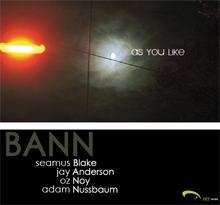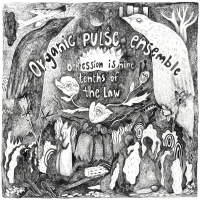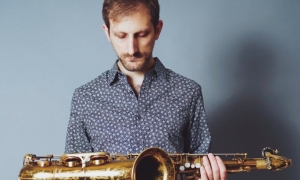Home » Jazz Articles » Interview » Esperanza Spalding: The Intimate Balance
Esperanza Spalding: The Intimate Balance

Fans of classical music and jazz have argued about music for years. If Wolfgang Amadeus Mozart and Duke Ellington had ever met, they may have looked at each other in awe—right before debating about bars and notes and solos... and, perhaps, the music would have been flowing just as easy as words. The time when classically trained musicians looked down on their improvising peers has been over for a long time, but certain misconceptions still prevail and, luckily, there are musicians ready to gently open those eyes that still remain closed.
If you can think of a place of solitude, where beautiful music is created, and feelings are exposed in the form of melodies, then Esperanza Spalding's Chamber Music Society (Concord Records, 2010) would find the perfect location to exist. There, the bassist/singer/songwriter has found a shelter for both classical and jazz music, combined with the same fragility with which a poet recites his verses.
There is something about the delicate sound of Spalding's voice that almost reflects that of a violin—enhanced in the way she plays the upright bass. The 25 year-old prodigy (at the age of 20, she was already a faculty member at the Berklee College of Music) digs deep into her young soul to visit the roots of the music that was first responsible for her creative being, and has found a balance between jazz and chamber music on an album that is both enchanting and intimate.
All About Jazz: What has changed for you, since 2008?
Esperanza Spalding: A lot of things have happened, and others continue to happen, wherever the landscape of my professional career is. There has been a lot of traveling and a lot of playing. It's been an evolution of learning myself—not only as a person, but as a musician—but it hasn't been anything like a miraculous event either. It's just part of life, I guess.
AAJ: What's the Chamber Music Society?
ES: Chamber Music Society is many, many things to me. One of the things that represents is this direction, this area in my music that is influenced and inspired by the years as a violinist. Therefore, there was this music that was in my mind, in my head, that never left, no matter how deep I got into jazz, because I spent 20 years playing the violin, classical music, and a lot of chamber music. So that was part of it.
There are other reasons, because I had this repertoire in my head that I was trying to make sense out of, and make a record of it. So I said, "You know what?, this has its own sound, and it's supposed to have its own record." And then, as the music was evolving, and I started writing more for strings and talking to people about it in the music community, I started to realize that there is really this kind of growing familiarity and growing interest and curiosity, obsession/passion between the jazz and the classical worlds, that have an interest in what the other party is doing. It felt like there was a movement that it was sort of developing and evolving in the music right now.
And also, the words Chamber Music Society , what do they mean? What it literally means to me, the definition, is an idea that I think it's really beautiful for all music and all performers: an idea that has a small group of musicians playing together, for entertainment for a party or a dinner; or music that people can play with their friends and experience the entertainment of this kind of music that is being played. So all of these things, combined, to me are really at the heart and at the concept, the real concept, behind the repertoire on this record. It's a long explanation [laughs].
 AAJ: It actually makes a lot of sense, after listening to the album. This is a very tender, delicate album. Where's all this sweet energy coming from?
AAJ: It actually makes a lot of sense, after listening to the album. This is a very tender, delicate album. Where's all this sweet energy coming from?ES: You know, I went through very enlightening experiences personally, and a lot of it had to do with sadness, some had to do with loss, and self-reflection, so it was an energy that it was really real to me at the time the music was coming about. And some of the compositions, once a few of the chord songs that I knew had to be on the record were established, I created the rest of the repertoire around that, to make like a very unified solid piece. So I think a couple of the songs that were absolute for me were "Knowledge of Good and Evil," "Little Fly" and "Apple Blossom," and those three songs are very tender, and are very melancholy in a way; that was just what I was feeling, and I felt I had to be honest.
I think a lot of people, even in my label, were expecting something more mainstream that would provide that proverbial crossover record for the jazz industry, but this felt real, like I really needed to make this record right now, and not only for me but for what I think is going on right now in the music business; it's important to reflect that. So it's real, it's a real record. And there is this unity within the classical and jazz world.
AAJ: You started working on some of these tracks years ago—but you're only 25; how is that possible?
ES: [Laughs] Any track in particular?

AAJ: "Little Fly" and "Apple Blossom" really got me going. When I heard Milton Nascimento's voice, on "Apple Blossom," I really wanted to pick up the phone and ask you about it.
ES: [Laughs] I know, I don't even believe that; I still can't believe that; I can't believe he is there. And that song was so much trouble for me. I have realized that "Apple Blossom" is a song that a lot of people relate to it, it speaks to them, and I don't really have a very good explanation about where the song came from. One day last, maybe March [2009], or maybe even earlier, it might have been September of 2008, in the fall, I was in the hotel taking a shower in the morning, and this scene just came to my head and then the story came, and I don't know where it came from, but I started crying right there, in the bathroom, and I was going "What the hell?! What's going on?" It's not PMS, the story just came and it hit me like a force.
I ran down to have breakfast, trying to clear my head, but it always remained in my head, this story of this man, and the way that he heals through this plant, this tree that represents the life of this person that he's lost. I don't know, I've never experienced anything like that, so I don't know what all of that means, but it just came out like that. And then for the last year-and-a-half I have been trying to put it together and reaching out to where the song was, and what it needed to become. And then at one point it hit me, that Milton should be the voice for this song. I heard it all in my head, but not having really experienced it myself it was difficult to finish the lyrics, and to make it real. So November last year, in the morning, I was supposed to go in the studio and I finished the lyrics 20 minutes before he got there. and he recorded it. It's very bizarre. It was very mysterious, I don't know where it came from, and I had wanted to do that for a long time.
AAJ: Gretchen Parlato and "Inutil Paisagem"?
ES: We have known each other for awhile. We have done a few little gigs, and she is becoming a dear friend. One day she came by my house and we were wondering what we could do, that would feature both of us. And we came up with that arrangement, and I feel that the intimacy, the timbre of that song, the color of it, the percussion, the bass and the vocals, it sounds a little different for people, but it captures that vibe of two people that get along and like each other, and are doing some music together for fun, for entertainment, the enjoyment of experiencing the music coming out of you. So it seemed quite on the line.
AAJ: The album starts with a song inspired by a poem by William Blake. Tell me about "Little Fly."
ES: Yes, William Blake. It's amazing. Sometimes just being home can have an impact in one's life. I have this book of postcards that have the painting that William Blake had made to go along with the poem, and the painting of "Little Fly" got my attention first, and then I read the poem. I thought it was really powerful. I don't know where it came from, but I was practicing one day and the melody came out, and somehow it just fit perfectly.
AAJ: Everything has a little story on this record.
ES: Absolutely. The way this record evolved was because of this repertoire that I had been developing little by little and didn't have a place for yet. And then I realized "Oh, my God, this is really crying out for some more content, or crying out to be on this album," and they all just found their place.
AAJ : Where does Esperanza the singer start and the musician end?
ES: That's a good question—I never saw it like that, I guess. It's not organized in my mind at all, really. I'm just going for what needs to be done, whether that means singing in a track or not, or I don't know... You caught me off guard! It doesn't really go with the way that I'm operating with my music. I certainly feel like all the elements, singing and playing, they're really part of the same motivation, which for me comes out of composition: that's my main passion, and what I really think rules everything else. It all comes from there.
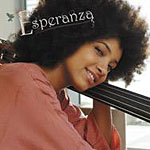 AAJ: What was the main idea on your mind when you started working on this project? What was the purpose, what you wanted to communicate?
AAJ: What was the main idea on your mind when you started working on this project? What was the purpose, what you wanted to communicate?ES: Well, I guess what I wanted to convey was that I wanted people to enjoy this type of ensemble, heavily inspired by a classical repertoire, classical chamber music. The feel, and the timber and the vibe of the record to me really draws its character from the influences of classical chamber music, and I wanted people who might not necessarily have turned to that yearning to experience that, coupled with improvisation and the types of style composition that is more similar to jazz composition, I suppose, although even that is a pretty big comment.
Sometimes we can come up with much deeper explanations after the fact, but really it's so really true to me, and it's so very real, and meaningful, and I wanted to share that. It's like when you draw something beautiful, and then you have to share it because you think maybe other people would enjoy it too, so you put it on your wall. And maybe that's the main thing here: it's an offering that I think people will enjoy and appreciate it. I believe in that.
AAJ: And how did you manage to combine both genres without allowing classical to overpower jazz, which happens often?
ES: One thing that we haven't talked about yet, which is a crucial factor, is that when I got the original idea to do this album, one of the places that I looked for inspiration in the arrangements and in the writing was in this Michael Brecker record, called Wide Angles (Verve 2003), that features the Quindectet, which is a pretty large chamber ensemble and rhythm section, and, of course, Michael Brecker with his wonderful musical self. So I didn't realize that Gil Goldstein's music, the producer, I had been transcribing and studying his work for years. I never even knew his name. And finally when I realized who arranged those parts on that record, I knew that I needed him for my record. Now I know that we are so incredibly compatible, conceptually, that it was just magic.
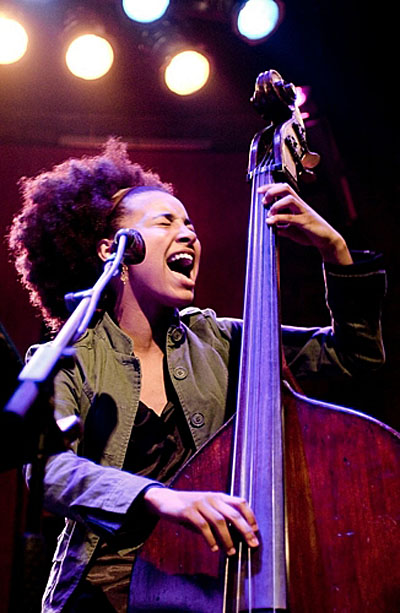 We sat together, we started talking about the concept, and I showed him what I had at the time, and I showed him the arrangements, and he said, "Oh, yes, I see what you want to do here," and we worked on everything. And I asked him to arrange a few things too, and he would take little ideas and then just do exactly what I envisioned! He totally got me. He was a big integral part, I think on keeping that music balanced. Some people might think that one overpowers the other, but I guess the motivation coming into the whole project, with the arrangements and everything was to create this community, this society that we all very democratically are offering our strengths and our work to the music. So I think we get that, that we are all kind of given equal significance and importance in the arrangements.
We sat together, we started talking about the concept, and I showed him what I had at the time, and I showed him the arrangements, and he said, "Oh, yes, I see what you want to do here," and we worked on everything. And I asked him to arrange a few things too, and he would take little ideas and then just do exactly what I envisioned! He totally got me. He was a big integral part, I think on keeping that music balanced. Some people might think that one overpowers the other, but I guess the motivation coming into the whole project, with the arrangements and everything was to create this community, this society that we all very democratically are offering our strengths and our work to the music. So I think we get that, that we are all kind of given equal significance and importance in the arrangements.AAJ: If you had to describe this album with just one word, what would it be?
ES: Intimate? That's the first word that just came to mind. Maybe that wouldn't be the right one, I'd have to think about that, but it is the first one that came to mind.
AAJ: How do you feel about being called "the future of jazz and instrumental music"?
ES: Oh, I think that would be pretty shallow. That doesn't mean anything. I'm 25 and I haven't done anything yet. There are people that are responsible for people like me to even be here, and those are the people that deserve to be called something like that. Everyone shares those moments and they all share the credit.
AAJ : You have a beautiful soul, and your music seems to reflect every single little thing about you. What is music to you? I'm asking this because of how you play and how you sing and how you write.
ES: The question to me would be "What is language? What is communication?" Whatever is the answer to that question, that's what music is to me.
AAJ : So music is a way for you to communicate with others.
ES: I guess so. There's really no answer. There's no answer to communication, to language. What is speech? There's so many ways to approach it. We can approach it from a scientific perspective, or we can approach it in a more philosophical way—you know, speech is the way we communicate our inner thoughts. A lot of people can understand what thinking and feeling and experiencing it is like...There are so many ways to describe what it is. So if you can think of what is the definition of communication, then you'll find what music is to me.
Selected Discography
Esperanza Spalding, Chamber Music Society (Concord Records 2010)
Lionel Loueke, Mwaliko (Blue Note, 2010)
Ana Carolina, Nove (Self-produced, 2009)
Mike Stern, Big Neighborhood (Heads Up, 2009)
Joe Lovano, Folk Art (Blue Note, 2009)
Fourplay, Energy (RCA Victor, 2008)
Esperanza Spalding, Esperanza (Concord Records 2008)
Esperanza Spalding, Junjo (Ayva Musica, 2006)
Christian Scott, Anthem (Concord, 2007)
Stanley Clarke, The Toys of Men (Heads Up, 2007)
Nando Michelin Group, Duende (Fresh Sound New Talent, 2006)
Ramona Borthwick, A New Leaf (Whaling City Sound, 2006)
Photo credits
Page 1: Johann Sauty, Courtesy of Esperanza Spalding
Page 2: Nelson G. Onofre
Page 3: Roger H. Sassaki
Tags
Esperanza Spalding
Interview
Esther Berlanga-Ryan
United States
duke ellington
Milton Nascimento
Gretchen Parlato
Michael Brecker
Gil Goldstein
About Esperanza Spalding
Instrument: Bass and vocals
PREVIOUS / NEXT
Esperanza Spalding Concerts
Support All About Jazz
 All About Jazz has been a pillar of jazz since 1995, championing it as an art form and, more importantly, supporting the musicians who make it. Our enduring commitment has made "AAJ" one of the most culturally important websites of its kind, read by hundreds of thousands of fans, musicians and industry figures every month.
All About Jazz has been a pillar of jazz since 1995, championing it as an art form and, more importantly, supporting the musicians who make it. Our enduring commitment has made "AAJ" one of the most culturally important websites of its kind, read by hundreds of thousands of fans, musicians and industry figures every month.



